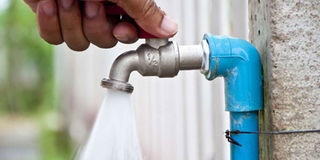The 'poison' lurking in bottled water

Previous research by Orb Media has found plastic particles in tap water but on a smaller scale. FILE PHOTO | NATON MEDIA GROUP
What you need to know:
- On Thursday, soft drinks giant Coca Cola admitted presence of microplastics in Dasani water.
- Plastic debris included polypropylene, nylon, and polyethylene terephthalate (PET), which is used to make bottle caps.
The world’s leading brands of bottled water are contaminated with tiny plastic particles that are likely seeping in during the packaging process, according to a major study across nine countries published on Wednesday.
“Widespread contamination” with plastic was found in the study, led by microplastic researcher Sherri Mason of the State University of New York at Fredonia, according to a summary released by Orb Media, a US-based non-profit media collective.
Researchers tested 250 bottles of water in Brazil, China, India, Indonesia, Kenya, Lebanon, Mexico, Thailand, and the United States.
Plastic was identified in 93 per cent of the samples, which included major name brands such as Aqua, Aquafina, Dasani, Evian, Nestle Pure Life and San Pellegrino.
DASANI
On Thursday, soft drinks giant Coca Cola admitted presence of microplastics in Dasani water.
In an interview with the BBC, Coca Cola said it had some of the stringent quality standards in the industry and used a “multistep filtration process” and acknowledged that microplastics “appear to be ubiquitous and therefore may be found at minute levels even in highly treated products”.
The Orb study found that plastic debris included polypropylene, nylon, and polyethylene terephthalate (PET), which is used to make bottle caps.
“In this study, 65 per cent of the particles we found were actually fragments and not fibres,” Mason told AFP.
“I think it is coming through the process of bottling the water. I think that most of the plastic that we are seeing is coming from the bottle itself, it is coming from the cap, it is coming from the industrial process of bottling the water.”
HEALH RISK
Particle concentration ranged from “zero to more than 10,000 likely plastic particles in a single bottle”, the report said.
On average, plastic particles in the 100 micron (0.10 millimetre) size range — considered “microplastics” — were found at an average rate of 10.4 plastic particles per litre.
Even smaller particles were more common — averaging about 325 per litre.
Experts cautioned that the extent of the risk to human health posed by such contamination remains unclear.
“There are connections to increases in certain kinds of cancer to lower sperm count to increases in conditions like ADHD and autism,” Mason said.
“We know that they are connected to these synthetic chemicals in the environment and we know that plastics are providing kind of a means to get those chemicals into our bodies.”
TAP WATER
Previous research by Orb Media has found plastic particles in tap water, too, but on a smaller scale.
“Tap water, by and large, is much safer than bottled water,” Mason said.
The three-month study used a technique developed by the University of East Anglia’s School of Chemistry to “see” microplastic particles by staining them using fluorescent Nile Red dye, which makes plastic fluorescent when irradiated with blue light.




